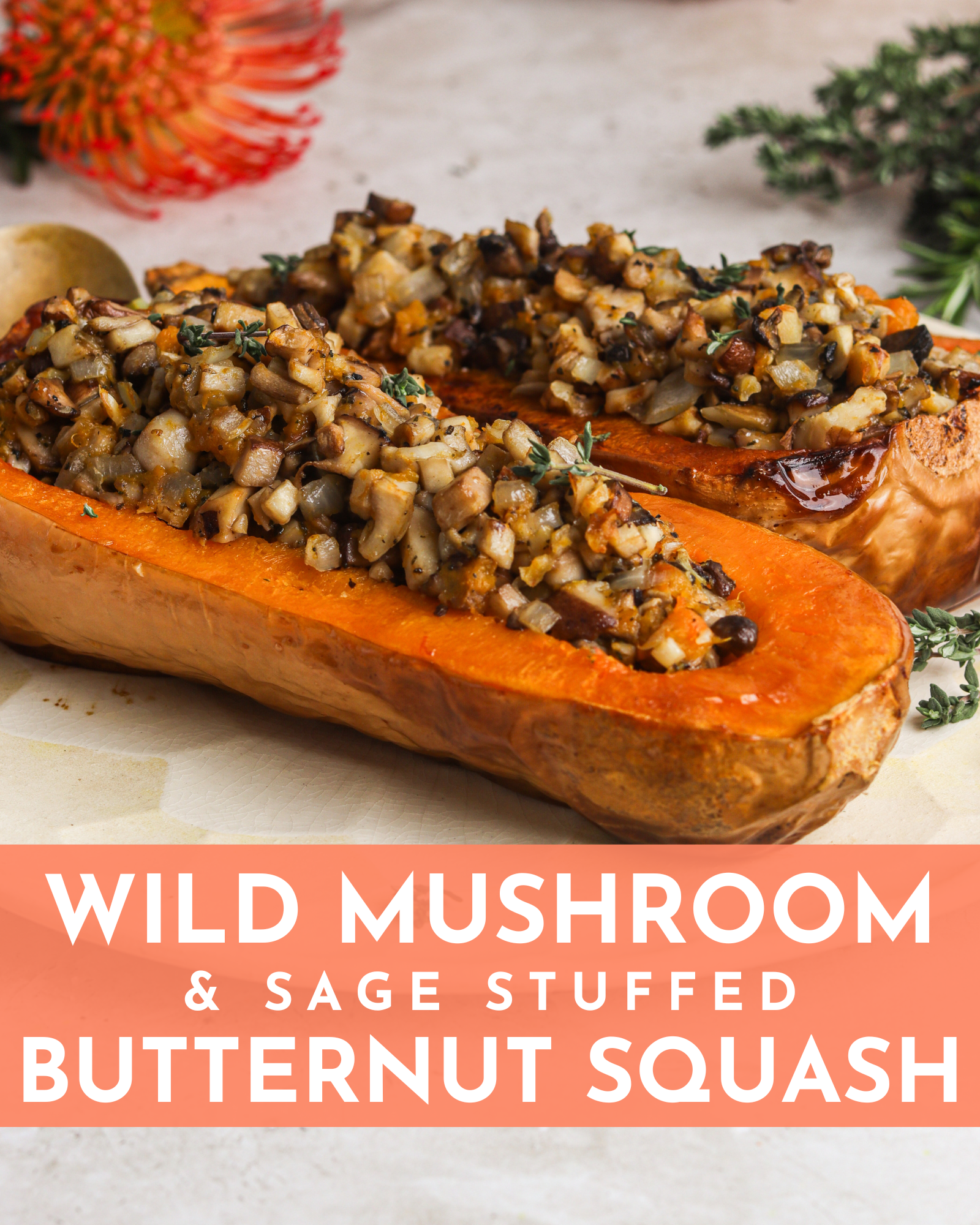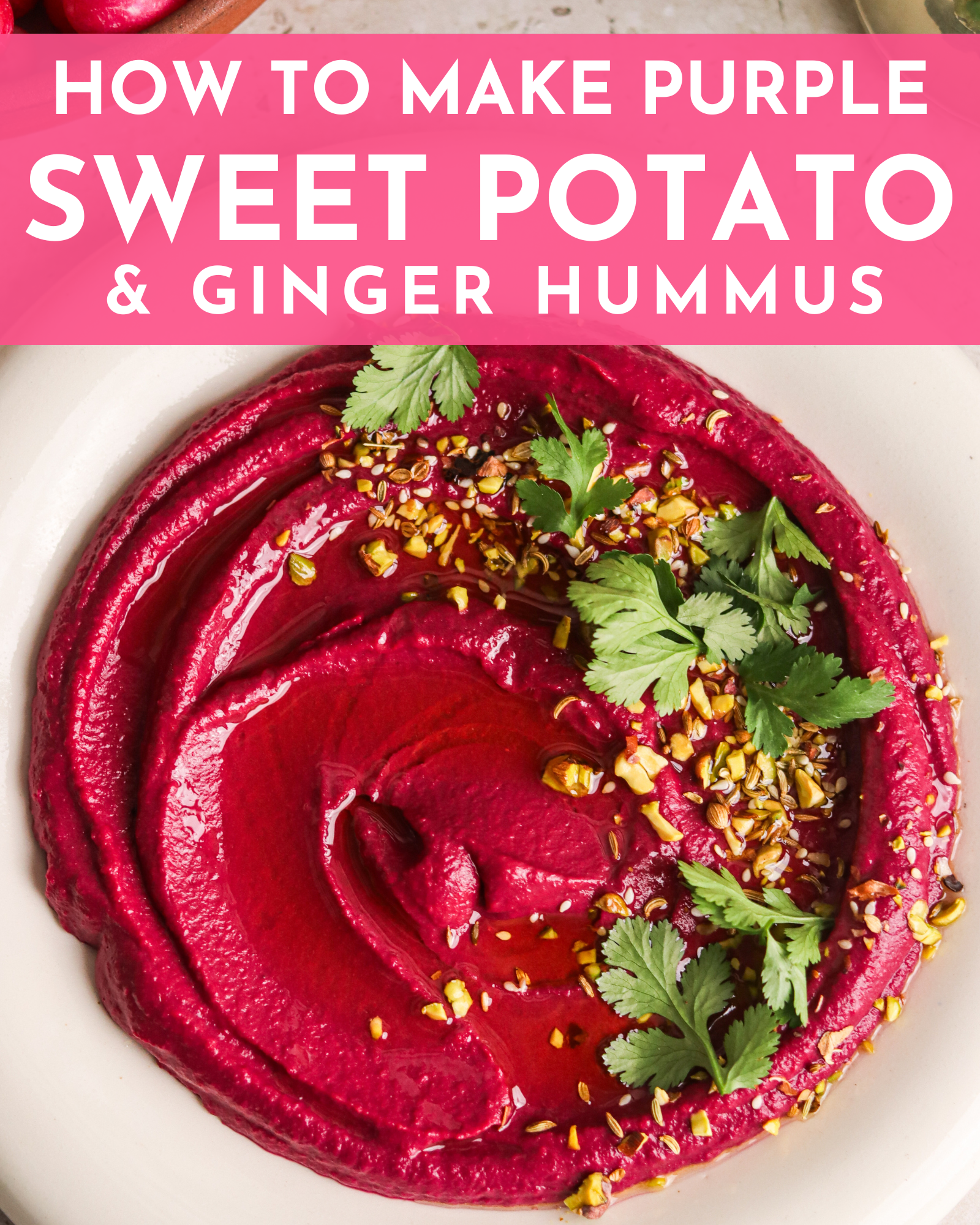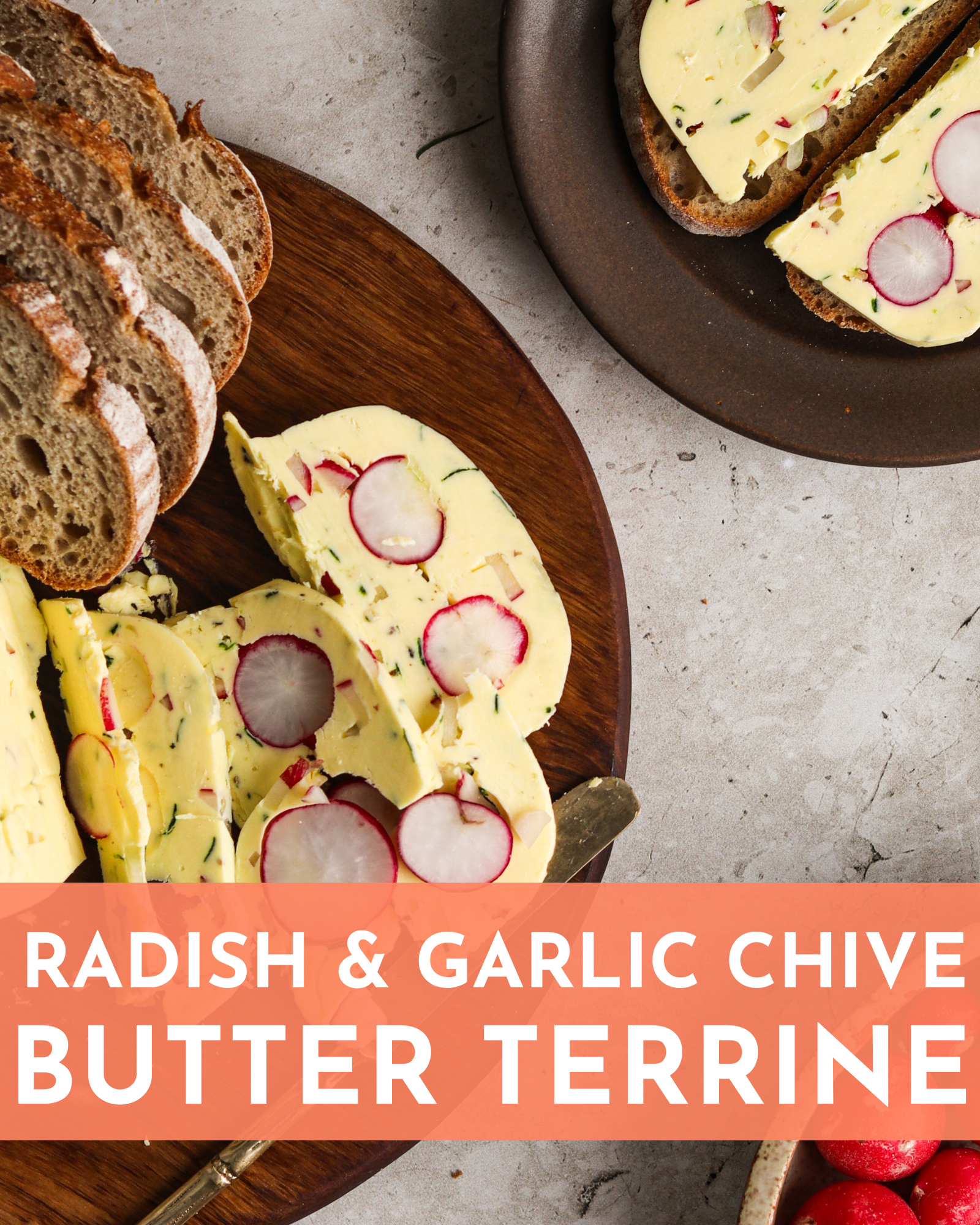This post may contain affiliate links. Please read our
disclosure policy
for more information.
You’re in the middle of cooking a fabulous meal, something that starts off sizzling on the stove. Maybe it’s a juicy steak or a savory skillet casserole. You’re stirring and flipping as a thought crosses your mind – wouldn’t it be great if I could finish this off in the oven? But then, you hesitate. You glance at your trusty frying pan and wonder, “Is this piece of cookware meant for oven use? Can I really just pop it in there?”
It’s a common moment in kitchens everywhere. One-pan cooking is a dream for its simplicity and flavor fusion, but the big question of whether your frying pan is oven-safe can cause confusion for the best of us. And it’s an important thing to consider – after all, not all pans are built the same, and understanding what makes a pan oven-safe is crucial.
Today, we’re going to explore just that, and dive into the factors that make a frying pan suitable (or not) for oven cooking. Is it a good idea or a recipe for disaster? What’s the best way to know if your pan can handle the heat? Whether you’re a seasoned cook or just starting to experiment with your culinary skills, knowing which pans are the best choice for oven use can make a big difference in your cooking adventures.
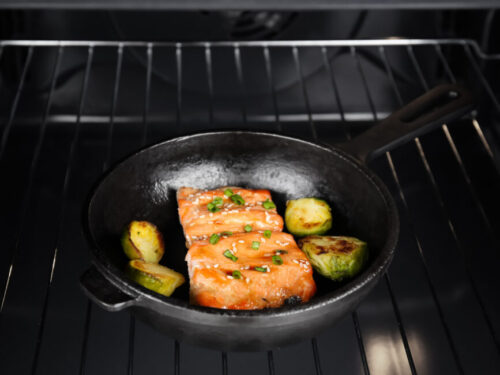
What is an Oven-Safe Pan?
In the world of cooking, the term ‘oven-safe pan’ might pop up quite often, especially when a recipe calls for a bit of stovetop-to-oven magic. But what exactly does it mean, and why would you want to use one? Let’s break it down.
Defining an Oven-Safe Pan
- Built for the Heat: Simply put, an oven-safe pan is a pan that’s designed to withstand the high temperatures of an oven without getting damaged. This means everything about the pan – from its main body to its handle and coating – can handle the heat.
- Materials Matter: These pans are usually made from materials that won’t warp, melt, or release harmful chemicals when exposed to oven temperatures. Think metals like stainless steel, cast iron, and certain types of aluminum.
Why Use an Oven-Safe Pan?
- Versatility in Cooking: The beauty of an oven-safe pan lies in its versatility. Imagine searing a steak or chicken to golden perfection on the stove and then transferring the same pan directly into the oven to finish cooking. It’s seamless, efficient, and ensures your food cooks evenly.
- Flavor Development: Using the same pan for both stovetop and oven cooking means you get to keep all those delicious bits and juices in one place, enhancing the overall flavor of your dish.
- Less Cleanup: One-pan recipes are a godsend for anyone who dreads washing up. With an oven-safe pan, you reduce the number of dishes you use, making cleanup a breeze.
- Perfect for Certain Recipes: Some dishes, especially those that require a good sear before slow cooking (like roasts or casseroles), benefit greatly from using an oven-safe pan. It ensures consistency in cooking and helps develop depth in flavors.
Understanding what an oven-safe pan is and its uses in your kitchen arsenal can elevate your cooking game significantly. It’s all about having the right tools for the right job, and an oven-safe pan is definitely a valuable player in the world of culinary arts.
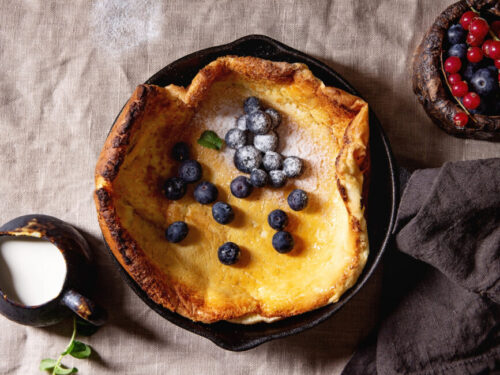
Some One-Pan Meal Examples
Now that we’ve covered what an oven-safe pan is, let’s explore some examples of one-pan meals. These are dishes that commonly start on the stovetop and finish in the oven.
Roast Chicken and Vegetables
- The Classic: A whole chicken seared for a crispy skin on the stove, then surrounded by a medley of vegetables and roasted in the oven. This dish is a staple for its simplicity and the rich flavors developed through both cooking methods.
Skillet Lasagna
- Comfort in a Pan: Start by browning your meat on the stovetop, layer with lasagna noodles, sauce, and cheese, then bake to perfection in the oven. It’s all the flavors of traditional lasagna with a fraction of the effort.
Dutch Baby Pancake
- Sweet or Savory: This puffy, oven-baked pancake starts on the stovetop to get the bottom set and then puffs up beautifully in the oven. Top it with fruit and syrup for a sweet treat, or ham and cheese for a savory version.
Frittatas
- Egg-cellent Choice: Begin with sautéing your choice of fillings (vegetables, meats, cheese) in a skillet, pour in beaten eggs, and let the frittata bake in the oven. It’s a great way to whip up a quick, nutritious meal with whatever you have on hand.
Braised Short Ribs
- Fall-off-the-Bone Goodness: Sear the ribs on the stovetop to lock in the flavors, then slowly braise them in the oven in a rich sauce. The result? Tender, flavorful meat that’s worth the wait.
Skillet Cornbread
- Southern Delight: Mix your cornbread batter, pour it into a preheated cast-iron skillet for a crispy crust, and then bake until golden brown. It’s the perfect side for chilis, stews, or enjoyed on its own.
Baked Risotto
- No-Stir Wonder: Start by sautéing onions and toasting rice on the stovetop, then add your broth and let the oven do the rest. It’s a hands-off method to a creamy, comforting risotto.
Each of these meals exemplifies the beauty of one-pan cooking with an oven-safe skillet or pan. Not only do they make for a delicious dining experience, but they also offer the convenience of fewer dishes to clean up afterward.
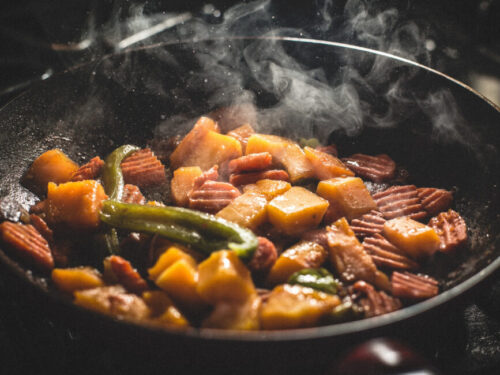
Can You Put Your Frying Pan in the Oven? It Depends…
Alright, let’s tackle that burning question: can your favorite frying pan take the heat of your oven? Well, it’s not a simple yes or no – it really depends on a few key factors.
Factors to Consider
- Handle Material: The first thing to check is the handles. Plastic or wooden handles are a no-go for the oven. Silicone handles might be oven-safe up to a certain temperature. Metal handles are typically your best bet for oven use.
- Pan Lids: Glass lids might not be as heat-resistant as the pan itself. Always check if they are oven-proof per the manufacture
- Construction and Coating: The bottom of the pan and its coating are crucial. Non-stick surfaces have temperature limits, while materials like cast iron or stainless steel can handle higher temperatures. Avoid putting pans with non-stick coatings or hard-coat aluminum pans in very hot ovens.
- General Guidelines: Always refer to the manufacturer’s website or the pan’s user manual for the maximum oven temperatures recommended for your specific pan.
Types of Frying Pans and Their Oven Compatibility
Oven-Safe Pans
- Cast Iron Skillets: The heavy-duty champion of oven-safe cookware. A cast-iron skillet can withstand very high temperatures (up to 600 degrees Fahrenheit!), often up to the maximum your oven can reach. They’re perfect for searing on the stove and then transferring to the oven.
- Stainless Steel Pans: Many stainless steel skillets are oven-going, but check for plastic handles. Pans with metal handles are generally a safe bet. They can usually handle high temperatures, making them versatile for both stovetop and oven use.
- Carbon Steel Pans: Similar to cast iron, carbon steel can usually handle the oven pretty well. They’re great for high-heat cooking but watch out for any non-metallic parts.
Non-Oven-Safe Pans
- Non-Stick Cookware: Here’s where you need to use caution. Non-stick pans, especially those with non-stick coatings, might release toxic fumes if heated to high temperatures. Check the manufacturer’s guidelines – many nonstick skillets are safe up to a certain degree Fahrenheit, but that’s often lower than the capabilities of metal pans.
- Ceramic Pans: As great as they are, we don’t recommend putting a ceramic pan in the oven. These pans are meant for low to medium heat, and you can wear the non-stick quality down faster by exposing them to high heat. Also, most ceramic pans contain plastic or wooden handles.
Using Your Pan in the Oven
- Precautions: If your pan is oven-safe, remember to use oven mitts when handling it – the entire pan, including the handle, will be hot. Avoid drastic temperature changes (like moving from oven to cold water) to prevent warping.
- Cleaning Post-Oven Use: For cast-iron or carbon steel pans, avoid soapy water; a wipe with paper towels is often enough. For stainless steel or non-stick, wait until the pan cools down before cleaning.
Again, always check for the specific temperature limits and use the pan accordingly to ensure its safety!
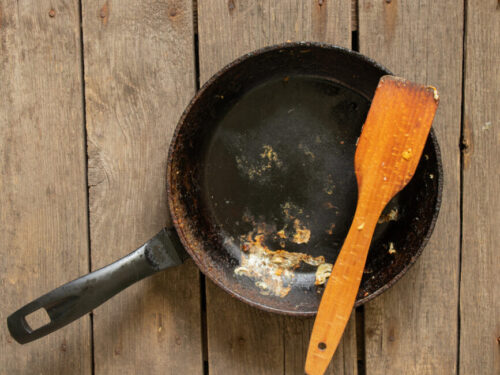
What Are the Risks of Putting the Wrong Frying Pan in the Oven?
So, you’re eyeing that frying pan on your stove and wondering what might go wrong if it’s not quite oven-ready. Let’s break down the risks of popping the wrong type of pan in your oven – because, honestly, it’s not just about possibly ruining dinner.
The Risks of Non-Oven-Safe Pans
- Handle Hazards: The handles of the pan are often the first casualty. Non-oven-safe handles, especially those made from plastic or wood, can melt or warp when exposed to oven temperatures. This not only damages the pan but can also pose a safety risk when you remove it from the oven.
- Coating Complications: Using a non-oven-safe pan, particularly those with non-stick coatings, can be risky. At high temperatures, these coatings can break down and release harmful fumes or leach unsafe chemicals into your food.
- Material Matters: The type of material your pan is made of plays a huge role. Certain materials, when exposed to oven temperatures, can warp or even crack, especially if they experience thermal shock (a rapid change in temperature).
Sticking to the Manufacturer’s Directions
- Pan Type and Instructions: The safest bet is always to follow the manufacturer’s directions for your specific pan type. Oven-safe frying pans are specifically designed to handle the oven’s heat, both in terms of the pan material and its handle.
- When in Doubt, Don’t Risk It: If you’re unsure whether your pan is oven-safe or if it’s missing the manufacturer’s guidelines, it’s better not to risk it. Opt for a pan that you know can handle the heat – both for the sake of your cookware and your cooking.
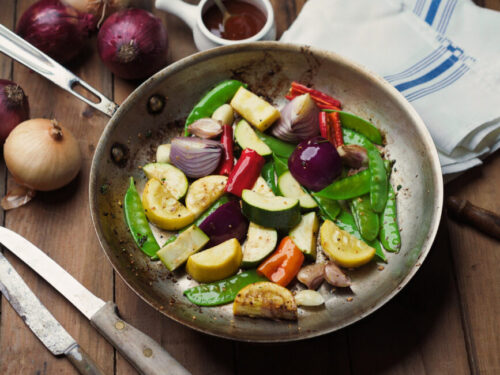
Everything Pans Out
And there we have it – your guide to navigating the world of oven-safe frying pans!
Whether you’re a seasoned chef or just finding your way around the kitchen, knowing which pans can take the heat (quite literally) is critical to cooking one-pan meals. So, the next time you’re about to transfer a dish from stovetop to oven, take a moment to consider your pan choice.
And if you’ve got any tips or stories about your own oven adventures with frying pans, feel free to share in the comments below. Your insights might just be the helping hand another home cook needs. Happy cooking, everyone!
This post may contain affiliate links. Please read our
disclosure policy
for more information.
This post may contain affiliate links. Please read our
disclosure policy
for more information.
You’re in the middle of cooking a fabulous meal, something that starts off sizzling on the stove. Maybe it’s a juicy steak or a savory skillet casserole. You’re stirring and flipping as a thought crosses your mind – wouldn’t it be great if I could finish this off in the oven? But then, you hesitate. You glance at your trusty frying pan and wonder, “Is this piece of cookware meant for oven use? Can I really just pop it in there?”
It’s a common moment in kitchens everywhere. One-pan cooking is a dream for its simplicity and flavor fusion, but the big question of whether your frying pan is oven-safe can cause confusion for the best of us. And it’s an important thing to consider – after all, not all pans are built the same, and understanding what makes a pan oven-safe is crucial.
Today, we’re going to explore just that, and dive into the factors that make a frying pan suitable (or not) for oven cooking. Is it a good idea or a recipe for disaster? What’s the best way to know if your pan can handle the heat? Whether you’re a seasoned cook or just starting to experiment with your culinary skills, knowing which pans are the best choice for oven use can make a big difference in your cooking adventures.

What is an Oven-Safe Pan?
In the world of cooking, the term ‘oven-safe pan’ might pop up quite often, especially when a recipe calls for a bit of stovetop-to-oven magic. But what exactly does it mean, and why would you want to use one? Let’s break it down.
Defining an Oven-Safe Pan
- Built for the Heat: Simply put, an oven-safe pan is a pan that’s designed to withstand the high temperatures of an oven without getting damaged. This means everything about the pan – from its main body to its handle and coating – can handle the heat.
- Materials Matter: These pans are usually made from materials that won’t warp, melt, or release harmful chemicals when exposed to oven temperatures. Think metals like stainless steel, cast iron, and certain types of aluminum.
Why Use an Oven-Safe Pan?
- Versatility in Cooking: The beauty of an oven-safe pan lies in its versatility. Imagine searing a steak or chicken to golden perfection on the stove and then transferring the same pan directly into the oven to finish cooking. It’s seamless, efficient, and ensures your food cooks evenly.
- Flavor Development: Using the same pan for both stovetop and oven cooking means you get to keep all those delicious bits and juices in one place, enhancing the overall flavor of your dish.
- Less Cleanup: One-pan recipes are a godsend for anyone who dreads washing up. With an oven-safe pan, you reduce the number of dishes you use, making cleanup a breeze.
- Perfect for Certain Recipes: Some dishes, especially those that require a good sear before slow cooking (like roasts or casseroles), benefit greatly from using an oven-safe pan. It ensures consistency in cooking and helps develop depth in flavors.
Understanding what an oven-safe pan is and its uses in your kitchen arsenal can elevate your cooking game significantly. It’s all about having the right tools for the right job, and an oven-safe pan is definitely a valuable player in the world of culinary arts.

Some One-Pan Meal Examples
Now that we’ve covered what an oven-safe pan is, let’s explore some examples of one-pan meals. These are dishes that commonly start on the stovetop and finish in the oven.
Roast Chicken and Vegetables
- The Classic: A whole chicken seared for a crispy skin on the stove, then surrounded by a medley of vegetables and roasted in the oven. This dish is a staple for its simplicity and the rich flavors developed through both cooking methods.
Skillet Lasagna
- Comfort in a Pan: Start by browning your meat on the stovetop, layer with lasagna noodles, sauce, and cheese, then bake to perfection in the oven. It’s all the flavors of traditional lasagna with a fraction of the effort.
Dutch Baby Pancake
- Sweet or Savory: This puffy, oven-baked pancake starts on the stovetop to get the bottom set and then puffs up beautifully in the oven. Top it with fruit and syrup for a sweet treat, or ham and cheese for a savory version.
Frittatas
- Egg-cellent Choice: Begin with sautéing your choice of fillings (vegetables, meats, cheese) in a skillet, pour in beaten eggs, and let the frittata bake in the oven. It’s a great way to whip up a quick, nutritious meal with whatever you have on hand.
Braised Short Ribs
- Fall-off-the-Bone Goodness: Sear the ribs on the stovetop to lock in the flavors, then slowly braise them in the oven in a rich sauce. The result? Tender, flavorful meat that’s worth the wait.
Skillet Cornbread
- Southern Delight: Mix your cornbread batter, pour it into a preheated cast-iron skillet for a crispy crust, and then bake until golden brown. It’s the perfect side for chilis, stews, or enjoyed on its own.
Baked Risotto
- No-Stir Wonder: Start by sautéing onions and toasting rice on the stovetop, then add your broth and let the oven do the rest. It’s a hands-off method to a creamy, comforting risotto.
Each of these meals exemplifies the beauty of one-pan cooking with an oven-safe skillet or pan. Not only do they make for a delicious dining experience, but they also offer the convenience of fewer dishes to clean up afterward.

Can You Put Your Frying Pan in the Oven? It Depends…
Alright, let’s tackle that burning question: can your favorite frying pan take the heat of your oven? Well, it’s not a simple yes or no – it really depends on a few key factors.
Factors to Consider
- Handle Material: The first thing to check is the handles. Plastic or wooden handles are a no-go for the oven. Silicone handles might be oven-safe up to a certain temperature. Metal handles are typically your best bet for oven use.
- Pan Lids: Glass lids might not be as heat-resistant as the pan itself. Always check if they are oven-proof per the manufacture
- Construction and Coating: The bottom of the pan and its coating are crucial. Non-stick surfaces have temperature limits, while materials like cast iron or stainless steel can handle higher temperatures. Avoid putting pans with non-stick coatings or hard-coat aluminum pans in very hot ovens.
- General Guidelines: Always refer to the manufacturer’s website or the pan’s user manual for the maximum oven temperatures recommended for your specific pan.
Types of Frying Pans and Their Oven Compatibility
Oven-Safe Pans
- Cast Iron Skillets: The heavy-duty champion of oven-safe cookware. A cast-iron skillet can withstand very high temperatures (up to 600 degrees Fahrenheit!), often up to the maximum your oven can reach. They’re perfect for searing on the stove and then transferring to the oven.
- Stainless Steel Pans: Many stainless steel skillets are oven-going, but check for plastic handles. Pans with metal handles are generally a safe bet. They can usually handle high temperatures, making them versatile for both stovetop and oven use.
- Carbon Steel Pans: Similar to cast iron, carbon steel can usually handle the oven pretty well. They’re great for high-heat cooking but watch out for any non-metallic parts.
Non-Oven-Safe Pans
- Non-Stick Cookware: Here’s where you need to use caution. Non-stick pans, especially those with non-stick coatings, might release toxic fumes if heated to high temperatures. Check the manufacturer’s guidelines – many nonstick skillets are safe up to a certain degree Fahrenheit, but that’s often lower than the capabilities of metal pans.
- Ceramic Pans: As great as they are, we don’t recommend putting a ceramic pan in the oven. These pans are meant for low to medium heat, and you can wear the non-stick quality down faster by exposing them to high heat. Also, most ceramic pans contain plastic or wooden handles.
Using Your Pan in the Oven
- Precautions: If your pan is oven-safe, remember to use oven mitts when handling it – the entire pan, including the handle, will be hot. Avoid drastic temperature changes (like moving from oven to cold water) to prevent warping.
- Cleaning Post-Oven Use: For cast-iron or carbon steel pans, avoid soapy water; a wipe with paper towels is often enough. For stainless steel or non-stick, wait until the pan cools down before cleaning.
Again, always check for the specific temperature limits and use the pan accordingly to ensure its safety!

What Are the Risks of Putting the Wrong Frying Pan in the Oven?
So, you’re eyeing that frying pan on your stove and wondering what might go wrong if it’s not quite oven-ready. Let’s break down the risks of popping the wrong type of pan in your oven – because, honestly, it’s not just about possibly ruining dinner.
The Risks of Non-Oven-Safe Pans
- Handle Hazards: The handles of the pan are often the first casualty. Non-oven-safe handles, especially those made from plastic or wood, can melt or warp when exposed to oven temperatures. This not only damages the pan but can also pose a safety risk when you remove it from the oven.
- Coating Complications: Using a non-oven-safe pan, particularly those with non-stick coatings, can be risky. At high temperatures, these coatings can break down and release harmful fumes or leach unsafe chemicals into your food.
- Material Matters: The type of material your pan is made of plays a huge role. Certain materials, when exposed to oven temperatures, can warp or even crack, especially if they experience thermal shock (a rapid change in temperature).
Sticking to the Manufacturer’s Directions
- Pan Type and Instructions: The safest bet is always to follow the manufacturer’s directions for your specific pan type. Oven-safe frying pans are specifically designed to handle the oven’s heat, both in terms of the pan material and its handle.
- When in Doubt, Don’t Risk It: If you’re unsure whether your pan is oven-safe or if it’s missing the manufacturer’s guidelines, it’s better not to risk it. Opt for a pan that you know can handle the heat – both for the sake of your cookware and your cooking.

Everything Pans Out
And there we have it – your guide to navigating the world of oven-safe frying pans!
Whether you’re a seasoned chef or just finding your way around the kitchen, knowing which pans can take the heat (quite literally) is critical to cooking one-pan meals. So, the next time you’re about to transfer a dish from stovetop to oven, take a moment to consider your pan choice.
And if you’ve got any tips or stories about your own oven adventures with frying pans, feel free to share in the comments below. Your insights might just be the helping hand another home cook needs. Happy cooking, everyone!
This post may contain affiliate links. Please read our
disclosure policy
for more information.







